Handmade masks keep alive a 500-year-old theatrical tradition
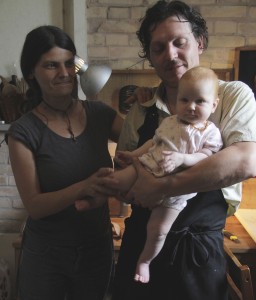
Mask-makers Alessandra Ceccarelli and Federico Gargagliano, along with their daughter. (all photos by Allison Butler)
Dark unkempt hair tucked underneath a cream fedora, billowing linen shirt revealing only a pinch of chest hair, and loose khaki-colored pants. He arrives at our table, having successfully completed the obstacle course through the rows of tables and chairs that line the café.
Leaning strongly to one side, he swings an arm forward to reveal a trunk. Tattered, jade green, complete with camel-colored buckles, the trunk finds its resting place on the table in front of us.
We sit like children waiting for a magic show to begin. It creaks open, and one by one he reveals his treasures: masks of Italy’s traditional Commedia Dell’Arte. Pulling out one after the other, he lays his shiny creations down as if they were eggs about to break, smiling proudly. The room fills with the scent of fresh leather.
A man of many talents, Federico Gargagliano does much more than show and tell. He is a master leather mask maker in the Commedia Dell’Arte art form. Gargagliano and his partner, Alessandra Ceccarelli, produce one-of-a-kind, hand-made leather masks under their company name, Fa Maschere. They also put the masks to good use, acting in their own theater troupe, Circa Teatro.
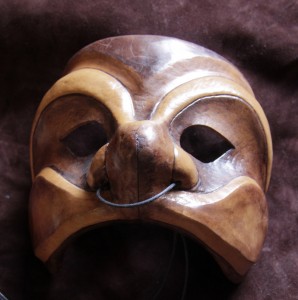
Arlecchino: From Bergamo. Speaks in Venetian dialect. The evil spirit of a deceased child, son of a witch, who came back as Arlecchino. Big mouth and flat cheeks signal he is poor and always looking for food. Gargagliano’s take: “Hungry, terrible, sly.”
Before his self-made success, Gargagliano was a street performer but wanted more. His journey to becoming a mask-maker took off while he was attending the University of Urbino. He met and began working under Georgio Di Marchi in 2003 during his studies. He graduated in 2004 with a degree in preserving art and began working full time as an apprentice for Di Marchi making leather masks.
Fortunate enough to travel around the world with his master, Gargagliano learned enough to take off on his own. In 2009 he started his company with Ceccarelli, who is also his girlfriend.
Ceccarelli focuses more on the delicate and detailed elements of the company. She makes all of the hats for the masks as well as creating artistic touches on the faces such as colorful paint and facial hair. When crafting the masks, Gargagliano uses hand-made bone and wood tools, compliments of Ceccarelli. Jacks of many trades, these two also perform in their theater troupe in the roles of Arlecchino and a servant named Cincilla.
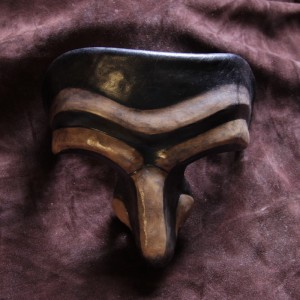
Il Doctorre: From Bologna. A comic character that makes fun of the professors at the university in Bologna. Mask covers only the forehead and nose, allowing the actor to have reddened cheeks to show his fondness for alcohol. Gargagliano’s take: “Pedantic, ridiculous, forgetful.”
Projecting a mysterious, dark, puzzling aura, Gargagliano fits right in with the devilish personality of Arlecchino. Translating in other languages as “Harlequin,” Arlecchino is known for his exaggerated tricks, violent movements, and outrageous transgressions. He is the most well-known stock character in the Commedia Dell’Arte, but there are many others.
Beginning in the early 1500s, this improvisational, interpretive art form brought relief to the public, allowing them to temporarily escape often difficult daily lives. Because the stories were told through gesture and universally understood expressions, they were accessible to everyone. Shows at this time were performed at open-air theaters. The actors were equipped with costumes and masks, transforming them into the characters that have existed since the 1500s and continue to exist today.
A common theme of the art form is love. The young people are often searching for the meaning of it, asking everyone in town. The servants play an important role, being the messengers for the rich as well as the brains behind most of the schemes. In the end, the older people are the only ones with real knowledge, educating the young.
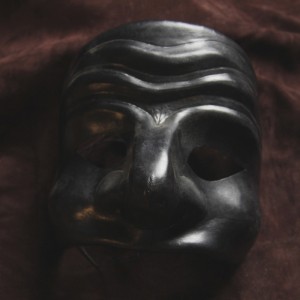
Pulcinella: From Naples. Poor worker who is often married but rarely in love. Dark mask filled with wrinkles and a wart, showing age. Gargagliano’s take: “Ancient, friendly.”
The style evolved from the improvisation style of the 1500s to a more pantomime style, with fewer words in the 1700s. Vastly popular during these 200 years, the art form was then forbidden in Italy under Napoleonic law in the 1800s. The only traces of the style could be found in puppets and in the red nose of a clown. The nose was a key component of the Commedia Dell’Arte stock character Pierrot, and it symbolized its survival.
Long after the Commedia’s sudden disappearance, Italy was faced with the difficulties of World War II. Having been effectively split into two, the country was seeking reunification. A group of artists contacted Amleto Sartori, who was famous for his work with leather theatrical masks, and asked him to revive the lost art. In 1953 Sartori made a set of classic Commedia Dell’Arte masks for a theater company in Venice, and the art form was alive again. People from all over Italy attended the shows.
The masks are the glue within the plays. Each element of the mask is carefully chosen, representing a different expression or gesture for the actor.
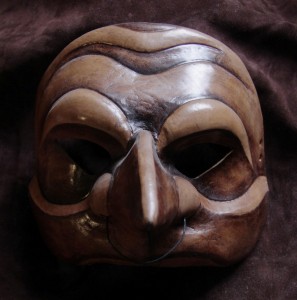
Il Capitano: Spanish Captain, introduced after the birth of the Commedia Dell’Arte. Represents foreign domination, a bold soldier. Large, meant to attract women and intimidate men. Gargagliano’s take: “Vainglorious, fresh, scared.”
Both Gargagliano and Ceccarelli enjoy the process of making these unique leather masks. It takes between four and five days and begins with the selection of leather. They use only one hundred percent natural leather from Tuscany, which is known for its high quality. Once the leather is selected, the shaping process begins.
On the first day the leather is wet down with warm water, molded by hand over a form with facial features carved into it, then nailed down to hold its shape. On the second day, when the leather is half dry, they use their hand-made tools to smooth it, allowing it to dry completely. On the third day the nose is the main focus. They begin by making a four-millimeter seam down the center of the nose, wetting the leather again to make it pliable, and finally sealing it in place with fish glue.
On the fourth day colors are added as well as wax to protect the mask against water damage, sweat, and daily wear and tear. During the fifth and final days they coat both sides of the mask with fish glue and oil. “What is well done remains,” says Gargagliano about the lengthy, manual process.
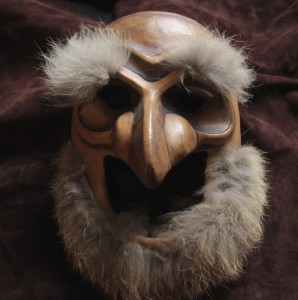
Pantalone Di Bisognosi: From Venice. Uses Venetian dialect. Top of the pecking order of stock characters; what he says goes. Mask adorned with a mustache and other white facial hair, symbolizing knowledge. Gargagliano’s take: “Kind, cheap.”
With all steps complete, it’s time to send the mask to its new owner. Gargagliano looks proud yet sad as he gingerly places a freshly finished mask into a shipping box. Having spent countless intensive hours on this piece of art, he is understandably attached. Ceccarelli looks on fondly, and explains, “Masks are like orphans, they need a body. When they find a body we are happy for them,” she says. Gargagliano smiles and closes the box, knowing it’s going to a good home.
Fa Maschere
329 934 3372
famaschere.com
info@famaschere.com
This article is from Urbino Now magazine’s Arte e Cultura section, which reports on the arts and culture of Urbino and the Le Marche region. Please view more magazine articles or order a complete printed copy of Urbino Now.